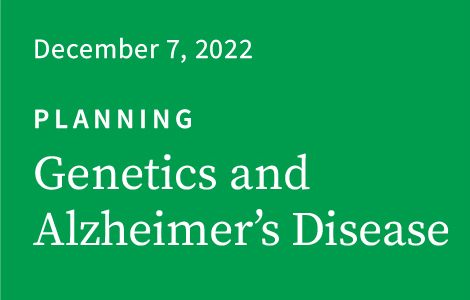Transcript
Genetics and Alzheimer’s Disease
A lot of us are concerned about our risk of developing Alzheimer’s disease, particularly if we’ve watched parents or siblings die of the disease. If we’ve lost partners to Alzheimer’s disease, we may wonder whether our children are destined for the same course. Researchers have found that we’re more likely to worry about having dementia than to actually develop it, and this gap is even more pronounced in people who have had a family member with dementia. So if we’ve watched our relatives die from Alzheimer’s disease, we tend to assume that we’re destined for the same fate—even when we don’t have any symptoms.
When we think about our familial risk of Alzheimer’s disease, we’re in part considering whether there’s something wrong with our DNA. We’re asking whether the seeds of Alzheimer’s disease were sown in our bodies years ago at the moment we were conceived—and whether we have any power to change our fate as adults.
We often think of genetics as a black-and-white indicator; if you have a mutation then you’ll get a disease, but if your DNA is normal, you’ll emerge scot-free. When it comes to Alzheimer’s disease, the story turns out to be far more complicated. For the vast majority of people with Alzheimer’s disease, we can’t point to a single genetic mutation as the cause of the symptoms. Instead, Alzheimer’s disease is usually the result of complex genetic and environmental factors, some of which we still don’t even understand.
Most people with Alzheimer’s disease carry mutations in some of the 70-odd “risk genes.” This is a group of genes that are associated with an increased risk of developing Alzheimer’s disease, but each of them alone isn’t enough to cause disease 100 percent of the time. Environmental factors such as education, diet, and head trauma also contribute to the risk of getting Alzheimer’s disease, so genetics alone don’t account for everything by any means.
The most famous risk gene for Alzheimer’s disease is called “ApoE.” This was the first risk gene that scientists identified, and it’s still the most strongly correlated with the disease. Each of us has two copies of the ApoE gene, and each copy comes in one of a few different versions, called ApoE2, ApoE3, and ApoE4. ApoE3 is the most common version of the gene. People who carry two copies of the ApoE2 version turn out to have a much lower risk of Alzheimer’s disease, whereas those who carry one or two copies of ApoE4 have a much higher risk of Alzheimer’s disease. Researchers estimate that about 50 percent of people with Alzheimer’s disease are ApoE4 carriers. For people who report lots of family members having Alzheimer’s disease that starts in their 60s, 70s, or 80s, we often wonder whether ApoE4 might be playing a role.
Patients often ask whether they should do genetic testing to find out if they are ApoE4 carriers. Some people even come to our clinic after finding out from 23andMe or another similar genetic testing company that they carry one or two copies of ApoE4. There are a couple of things to consider when it comes to finding out your ApoE status. First, knowing if you carry ApoE4 won’t tell you whether or not you will get Alzheimer’s disease. We’ve seen many people in our research center who have two copies of ApoE4 but do not have symptoms of Alzheimer’s disease, and likewise we know that half of people with Alzheimer’s disease don’t have any copies of ApoE4. In the end, knowing your ApoE status doesn’t tell us much more about your genetic risk of Alzheimer’s disease than what we can already glean from your family history. Second, it’s important to keep in mind that we don’t typically recommend any changes to family-building plans based on the result of ApoE4 testing. Even if you are an ApoE4 carrier, we don’t recommend using reproductive technology to decrease the risk of passing it on. In short: Outside of research endeavors, it’s not usually clinically useful to find out your ApoE status.
So, when should you do genetic testing for Alzheimer’s disease? We tend to suggest this in patients who have symptoms before age 65 and also have a strong family history of Alzheimer’s. These are the people at the highest risk of carrying a mutation in one of three genes that can single-handedly cause Alzheimer’s disease. Less than 1 percent of people with Alzheimer’s disease carry a mutation in one of these genes—so it’s very uncommon, even in people where the disease starts before age 65—but identifying people with these mutations can help families make decisions about genetic testing and management.
If you’re wondering if you’re in this group, consider bringing it up with a neurologist and asking whether you should see a genetic counselor. Genetic counselors often work closely with neurologists to help decide which genes could be useful to evaluate and also to help patients and their families cope with the prospect of receiving genetic information.
While we don’t have control over our genetic status, there are lifestyle changes that can significantly affect our risk of developing disease. A recent study found that 40 percent of the burden of Alzheimer’s disease is attributable to modifiable risk factors like high blood pressure, diabetes, and obesity. Regardless of what’s contained in your genes, one of the most effective things you can do to decrease your risk of Alzheimer’s disease is exercise. The best outcomes come from doing at least 40 minutes of aerobic exercise, three to four days a week. Diet-wise, the Mediterranean diet has been associated with the lowest risk of Alzheimer’s disease, but limiting alcohol and not smoking have also shown a huge benefit. Finally, social and intellectual engagement are critical for preserving cognitive function.
Sara Manning Peskin, MD, MS
Assistant Professor of Clinical Neurology
University of Pennsylvania

